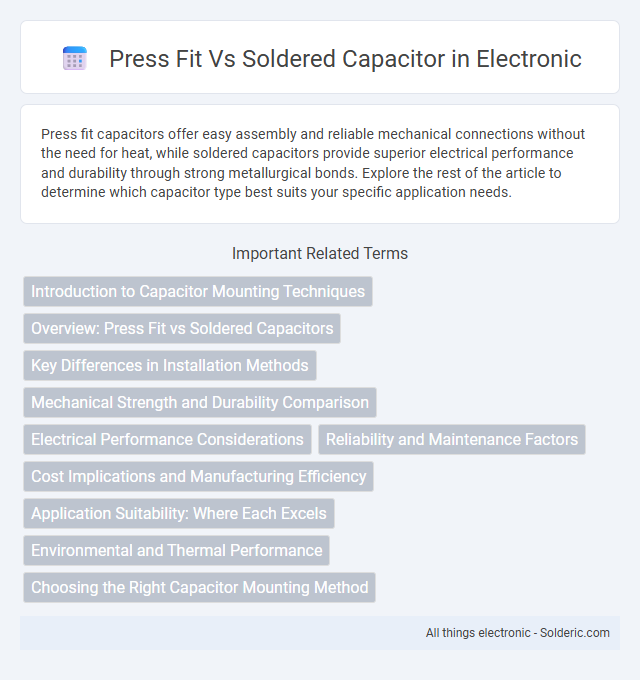Press fit capacitors offer easy assembly and reliable mechanical connections without the need for heat, while soldered capacitors provide superior electrical performance and durability through strong metallurgical bonds. Explore the rest of the article to determine which capacitor type best suits your specific application needs.
Comparison Table
| Feature | Press Fit Capacitor | Soldered Capacitor |
|---|---|---|
| Connection Type | Mechanical press-fit insertion | Permanent soldered joints |
| Installation | Tool-required press-fit process | Soldering using soldering iron or wave soldering |
| Reliability | Good mechanical stability; possible intermittent contact over time | High electrical stability and durability |
| Rework | Easy removal and replacement | Requires desoldering, more complex and time-consuming |
| Thermal Stress | Low thermal stress during installation | Higher thermal exposure during soldering |
| Cost | Lower assembly cost due to no soldering | Additional cost for solder and soldering process |
| Application | Ideal for prototypes and repair-friendly designs | Suitable for mass production and high-reliability applications |
Introduction to Capacitor Mounting Techniques
Press fit and soldered capacitors represent two primary mounting techniques used in electronics assembly. Press fit capacitors rely on a mechanical connection where component leads are inserted into plated through-holes, offering advantages such as easier rework and reduced thermal stress compared to soldered connections. Soldered capacitors, by contrast, utilize solder to create an electrical and mechanical joint, ensuring robust conductivity and mechanical stability essential for high-reliability applications.
Overview: Press Fit vs Soldered Capacitors
Press fit capacitors offer reliable mechanical connections by inserting leads into plated through-holes without solder, reducing thermal stress and simplifying assembly in high-volume manufacturing. Soldered capacitors provide strong electrical and mechanical bonds through molten solder, ensuring robust conductivity but requiring precise temperature control during reflow processes. The choice between press fit and soldered capacitors depends on factors such as production scalability, thermal management, and long-term reliability in electronic assemblies.
Key Differences in Installation Methods
Press fit capacitors are installed using a mechanical insertion process where the capacitor's leads are pressed into plated holes on the PCB, creating a reliable physical and electrical connection without heat. Soldered capacitors require melting solder to join the capacitor leads to the PCB pads, providing a strong electrical bond but involving thermal stress during assembly. Your choice between press fit and soldered capacitors depends on factors such as assembly speed, reworkability, and thermal sensitivity of the components.
Mechanical Strength and Durability Comparison
Press fit capacitors offer superior mechanical strength due to their robust interference fit, enhancing vibration resistance and reducing the risk of joint failure in high-stress environments. Soldered capacitors rely on solder joints that can degrade under thermal cycling and mechanical fatigue, potentially leading to cracked solder and electrical discontinuity. Thus, press fit technology provides greater durability for applications demanding long-term mechanical stability and reliability.
Electrical Performance Considerations
Press fit capacitors offer superior electrical performance by providing reliable mechanical connections with minimal parasitic inductance, enhancing signal integrity in high-frequency applications. In contrast, soldered capacitors ensure stable electrical contact but may introduce higher parasitic elements due to inconsistent solder joints, potentially affecting performance under thermal stress. Your choice between press fit and soldered capacitors should consider these factors to optimize circuit reliability and efficiency.
Reliability and Maintenance Factors
Press fit capacitors offer enhanced reliability by eliminating solder joint fatigue and reducing thermal stress during assembly, which lowers the risk of electrical failures over time. Soldered capacitors, while providing a strong mechanical bond, can suffer from solder cracking and require more maintenance due to potential joint degradation caused by thermal cycling. Your choice between press fit and soldered capacitors should consider maintenance accessibility and the expected operational environment to ensure long-term performance stability.
Cost Implications and Manufacturing Efficiency
Press fit capacitors reduce assembly time by eliminating soldering steps, leading to lower labor costs and faster production cycles, enhancing manufacturing efficiency. Soldered capacitors incur higher material and labor expenses due to solder paste usage, reflow processes, and quality control measures. Your choice between press fit and soldered capacitors significantly impacts overall production cost and throughput, depending on volume and reliability requirements.
Application Suitability: Where Each Excels
Press fit capacitors excel in applications requiring easy replacement and mechanical robustness, such as in high-vibration environments like automotive and industrial electronics. Soldered capacitors provide superior electrical performance and reliability, making them ideal for high-frequency circuits and densely packed printed circuit boards where stable connections and minimal parasitic effects are critical. Selecting between press fit and soldered capacitors depends on prioritizing maintenance convenience versus electrical integrity in the specific application context.
Environmental and Thermal Performance
Press fit capacitors offer superior thermal resilience due to their robust mechanical connection, reducing the risk of thermal stress-induced failures compared to soldered counterparts. Their environmental performance is enhanced by eliminating solder, which often contains lead and other harmful substances, making press fit capacitors a more eco-friendly and recyclable option. This solid-state connection maintains stable electrical properties under extreme temperature variations, ensuring reliable operation in harsh environments.
Choosing the Right Capacitor Mounting Method
Choosing the right capacitor mounting method hinges on factors like durability, repairability, and signal integrity. Press fit capacitors offer easier replacement and reduce risk of heat damage during assembly, while soldered capacitors provide stronger mechanical bonds and better electrical connectivity. Your decision should consider application requirements, including mechanical stress levels and maintenance needs, to ensure optimal performance and reliability.
Press fit vs soldered capacitor Infographic

 solderic.com
solderic.com